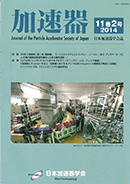Volume 11, Issue 2
Displaying 1-10 of 10 articles from this issue
- |<
- <
- 1
- >
- >|
Preface
-
2014 Volume 11 Issue 2 Pages 65
Published: July 31, 2014
Released on J-STAGE: March 01, 2023
Download PDF (565K)
Review
-
2014 Volume 11 Issue 2 Pages 66-77
Published: July 31, 2014
Released on J-STAGE: March 01, 2023
Download PDF (775K)
Topics
-
2014 Volume 11 Issue 2 Pages 78-87
Published: July 31, 2014
Released on J-STAGE: March 01, 2023
Download PDF (1885K) -
2014 Volume 11 Issue 2 Pages 88-98
Published: July 31, 2014
Released on J-STAGE: March 01, 2023
Download PDF (856K) -
2014 Volume 11 Issue 2 Pages 99-108
Published: July 31, 2014
Released on J-STAGE: March 01, 2023
Download PDF (1531K)
Meeting Report
-
2014 Volume 11 Issue 2 Pages 109-114
Published: July 31, 2014
Released on J-STAGE: March 01, 2023
Download PDF (1123K) -
2014 Volume 11 Issue 2 Pages 115-117
Published: July 31, 2014
Released on J-STAGE: March 01, 2023
Download PDF (675K) -
2014 Volume 11 Issue 2 Pages 118-121
Published: July 31, 2014
Released on J-STAGE: March 01, 2023
Download PDF (748K) -
2014 Volume 11 Issue 2 Pages 122-126
Published: July 31, 2014
Released on J-STAGE: March 01, 2023
Download PDF (869K)
Recent PhD.Graduates
-
2014 Volume 11 Issue 2 Pages 127-128
Published: July 31, 2014
Released on J-STAGE: March 01, 2023
Download PDF (722K)
- |<
- <
- 1
- >
- >|
